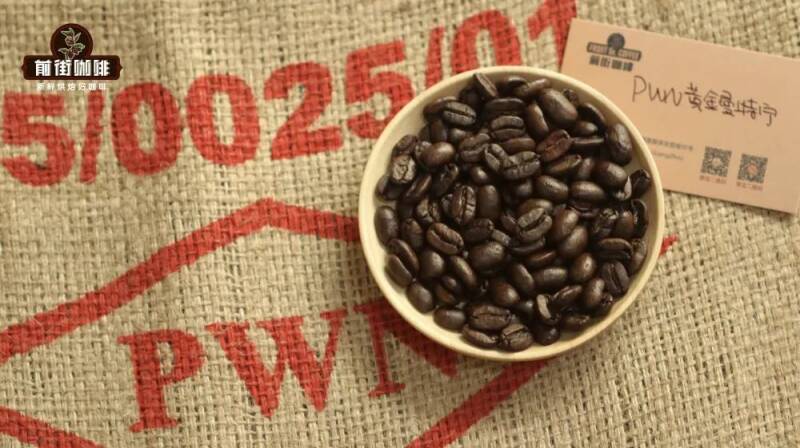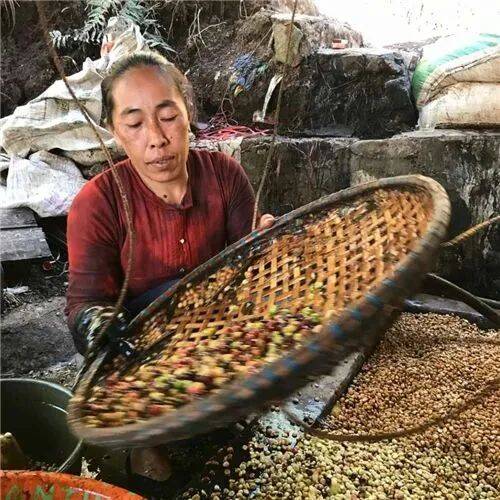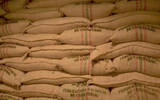What specific steps are required for the Indonesian wet planing method? Why does golden mantinin have a special herbal flavor?
As the most roasted product in Qianjie bean list, Mantenin coffee has rich roasted aroma, solid and mellow taste and low acidity. When using deep roasting, we can not only experience its long bitter rhyme, but also enjoy its elegant sweetness. It is very intriguing to feel its unique fragrance through smell and taste at the same time.

At this time, some friends may ask, they are also medium-and deep-roasted coffee beans, why only Manning has this unique flavor?
Mantenin comes from Indonesia's mysterious island of Sumatra. Sumatra is divided into eight provinces, of which only the high-altitude provinces of Aceh and Jiangsu grow Arabica coffee on a large scale. The biggest difference with many coffee producing areas is that the weather in Indonesia is changeable, humid and rainy, with annual humidity between 7090% and 90%. Sometimes it is sunny in the morning and heavy rain in the afternoon, and typhoons come soon, with annual rainfall even reaching more than 2000mm.

In such a bad climate, it is very difficult and time-consuming to dry the shell beans completely to the specified moisture content, and Indonesia is a large coffee country for the purpose of mass production, in order to shorten the processing time of coffee beans and sell them as soon as possible, so they summed up a unique semi-washing method: wet planing.
Wet planing (Wet Hulled), known as "Giling Basah" in Indonesian, has been used in coffee production for many years, like traditional treatments such as water washing, sun exposure and honey treatment. At present, wet planing coffee is still mainly produced in Indonesia, mainly in the northern part of Sumatra and Sulawesi.
At first, the sun processing was mainly used here, but the quality was unstable, and then it was changed to a half-sun method similar to that in Brazil. Farmers will first peel off the coffee cherries with a machine, pour them directly into a pool, remove the defective shell beans floating on the liquid surface, and then remove the beans that have sunk underneath and put them into a bucket for brief fermentation. the specific fermentation time will depend on the situation, usually only a few hours. There is still a small amount of pectin left on the fermented bean shell, and the shell beans are left outside to dry after scrubbing.
However, it is not as dry as in Brazil to dry the sticky shelled beans outdoors for several days after removing the peel of the coffee, because doing so in warm and rainy Indonesia will only make them mildew directly, so they can barely dry for a day or two.
When the moisture content of shell beans is reduced to 3050%, it will be acquired by brokers. At this time, the pectin layer has not yet solidified and the bean body is still semi-hard and semi-soft, but it needs to be brought back to the treatment plant to grind off the seed shell with a special machine in time to avoid excessive fermentation and sour smell.
Shelling raw beans is more difficult, so a more powerful sheller is needed.
As the shelling under the wet planing method is more difficult, the machine needs to use greater friction to tear off the parchment layer clinging to the raw beans. At this stage, white or green mucus usually flows out of it. due to long-term mucus soaking and humid environment, the raw beans become soft, whitish and swollen and form grayish green. After friction stirring, raw beans are also more likely to be crushed or crushed, especially at both ends, forming a small gap, like a sheep's hoof, which is why the ratio of sheep's hoof beans is higher in Sumatran coffee.
You know, coffee beans have four layers of protection: pericarp, pectin, seed shell and silver skin, but the wet planing method cuts off the third and fourth layers of protection midway, that is to say, coffee beans with wet planing are directly exposed to "inner beans" for sunbathing.
After the shell is ground off by the machine, the beans will continue to dry until the moisture content reaches 12% to 15%. The coffee beans can be collected into woven bags, usually 40 kg and 80 kg each. Finally, the raw beans are sent to machine selection to remove a variety of impurities and classify them according to their particle size.
Not only that, because the four layers of protective bodies have been removed before drying, beans are completely exposed to the hot sun or moist air in the form of "naked", and the drying speed will be very fast, so whether it is fermentation time or drying time, the wet planing process is shorter than the traditional washing process, thus saving a lot of labor.
Although the wet planing method shortens the drying time of raw beans, the defect rate is greatly improved due to the roughness of the production process. First of all, there must be some natural defects in the harvest of coffee fruit, followed by the "crushing" of the shelled part, the dampness during the transportation of wet shell beans, and the damage of sunlight and moisture to naked raw beans. Finally, the uneven drying caused by irregular weather will also reduce the flavor. This is the main reason why high-level Mantenin has to go through so many hand selections.
The operation of direct exposure to a humid environment will inevitably make the inner bean breed by a variety of bacteria, thus affecting the final quality of coffee. But interestingly, "pollution" is not a completely bad thing. For example, some bacteria have brought a unique flavor to Indonesian coffee. Some academic studies have believed that the wood flavor, immortal grass flavor, earthy flavor and spice flavor of Sumatran coffee should be created by mold. Finally, coffee beans in some Lemillard reaction, caramelization reaction, the substance into such as caramel, black aroma, coffee will show a highly recognizable smell, that is, what we call "regional flavor".
It can be seen that Mantenin's unique aroma of herbs and sunwood are caused by the high local humidity, which forced the whole post-processing process to be divided into three different stages to dry coffee beans.
-END-
Important Notice :
前街咖啡 FrontStreet Coffee has moved to new addredd:
FrontStreet Coffee Address: 315,Donghua East Road,GuangZhou
Tel:020 38364473
- Prev

Popular knowledge of hand-flushing theory: What factors can cause over-extraction and under-extraction of coffee?
When making coffee, everyone should have the same goal, which is how to make it taste good. Although people have different definitions of good drinking, as long as we generally ensure that it is neither extracted nor obviously under-extracted, we naturally know that it is a good cup of coffee. Because of this, yes
- Next

Colombia suffers from heavy rain! Coffee prices soar again
Recently, according to data released by the National Coffee Growers Council (FNC) of Colombia, Colombia's coffee production in October 2024 totaled 1.33 million bags (60 kilograms per bag), an increase of 16% compared with the same period last year, and also exceeded the 1.07 million bags in September, an increase of 24%. in this year's
Related
- What is the standard process for the purpose of coffee cup testing? What is the difference between hand-brewed coffee and cup testing?
- How to use hand-brewed coffee paragon small golden balls? How does cold coffee lock in the aroma of coffee?
- Is American coffee black? What is the difference between American coffee and drip coffee?
- Unexpected! Well-known tea beverage brand Lele Tea will withdraw from the Zhengzhou market!
- Starbucks enters the fashion and beauty industry?! Netizen: Give me an ice American eye cream
- Why can American refills for free? The difference between Americano and American drip pot coffee
- Being chased out of the rain in front of Starbucks?! Store: Sheltering from rain under umbrellas poses a safety hazard
- The white moonlight has changed?! Lucky launches "Big Winter Pear American"
- Hand-brewed coffee three-stage method, high-sweet and universal brewing method to share! What does the high sweet water level of hand-brewed coffee mean?
- What is the difference between raw, refined and full espresso coffee? How to extract espresso and taste good?

